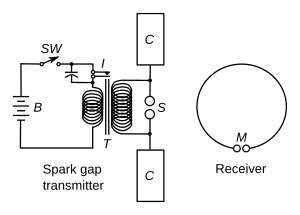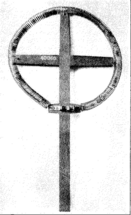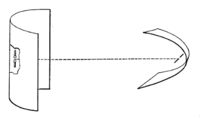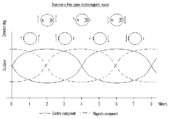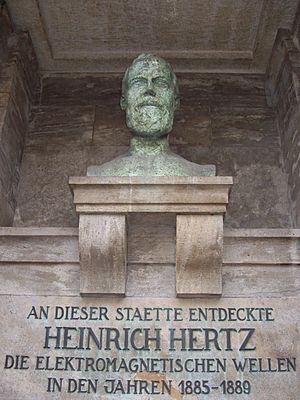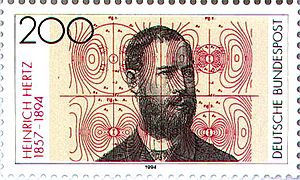Heinrich Hertz facts for kids
Quick facts for kids
Heinrich Hertz
|
|
|---|---|
 |
|
| Born |
Heinrich Rudolf Hertz
22 February 1857 |
| Died | 1 January 1894 (aged 36) |
| Alma mater | University of Munich University of Berlin |
| Known for | Contact mechanics Electromagnetic radiation Emagram Parabolic antenna Photoelectric effect Hertzian cone Hertzian dipole antenna Hertzian oscillator Hertz vector Hertz–Knudsen equation Hertz's principle of least curvature |
| Awards | Matteucci Medal (1888) Rumford Medal (1890) |
| Scientific career | |
| Fields | Electromagnetism Electrical engineering Contact mechanics |
| Institutions | University of Kiel University of Karlsruhe University of Bonn |
| Doctoral advisor | Hermann von Helmholtz |
| Doctoral students | Vilhelm Bjerknes |
| Signature | |
 |
|
Heinrich Rudolf Hertz (born February 22, 1857 – died January 1, 1894) was a German physicist. He was the first to clearly show that electromagnetic waves really exist. These waves had been predicted by James Clerk Maxwell's math equations. Today, the unit for measuring frequency, called "hertz", is named after him. Frequency tells you how many times something happens in one second.
Contents
About Heinrich Hertz
Heinrich Rudolf Hertz was born in 1857 in Hamburg, which was then an independent state in Germany. He came from a well-off and educated family. His father was Gustav Ferdinand Hertz and his mother was Anna Elisabeth Pfefferkorn.
Early Life and Education
While studying at the Gelehrtenschule des Johanneums in Hamburg, Hertz showed a natural talent for science and languages. He even learned Arabic. He went on to study science and engineering in German cities like Dresden, Munich, and Berlin. There, he learned from famous scientists like Gustav Kirchhoff and Hermann von Helmholtz.
In 1880, Hertz earned his PhD from the University of Berlin. He then stayed for three more years to do advanced research, working as an assistant to Helmholtz. In 1883, Hertz became a lecturer in physics at the University of Kiel. By 1885, he was a full professor at the University of Karlsruhe.
Family Life
In 1886, Hertz married Elisabeth Doll. Her father was a geometry lecturer at Karlsruhe. Heinrich and Elisabeth had two daughters. Johanna was born in 1887, and Mathilde was born in 1891. Mathilde later became a well-known biologist. During these years, Hertz did his most important work on electromagnetic waves.
In 1889, Hertz became a Professor of Physics and the head of the Physics Institute in Bonn. He held this job until he died. During this time, he also worked on theoretical mechanics. His book on this topic was published after his death in 1894.
His Passing
In 1892, Hertz became ill with an infection. He had several operations to treat it. He died at the age of 36 in Bonn, Germany, in 1894. He was buried in the Ohlsdorf Cemetery in Hamburg.
Hertz's wife, Elisabeth, never remarried. His daughters, Johanna and Mathilde, never married or had children. This means Heinrich Hertz has no living descendants today.
Heinrich Hertz's Discoveries
Proving Electromagnetic Waves Exist
In 1864, a Scottish physicist named James Clerk Maxwell created a full theory about electromagnetism. This theory, now called Maxwell's equations, said that electric and magnetic fields could travel through space together as "electromagnetic waves". Maxwell thought that light was made of these waves, but no one had been able to prove it or create other types of electromagnetic waves.
In 1879, Hertz's teacher, Helmholtz, suggested that Hertz's main project should be to test Maxwell's theory. Helmholtz even offered a prize for anyone who could prove an electromagnetic effect in materials that don't conduct electricity. Hertz initially thought it was too hard to build the right equipment.
In 1886, after becoming a professor at Karlsruhe, Hertz was experimenting with some coils. He noticed that when he sent an electric spark into one coil, it created a spark in another coil nearby. This gave him an idea of how to build the equipment needed to test Maxwell's theory.
He built a special antenna using two long wires with a spark gap between them. He used a high-voltage coil to create sparks in this gap. This made and sent out what we now call radio waves. He used a simple loop antenna with another spark gap to detect these waves.
Between 1886 and 1889, Hertz did many experiments. He proved that the effects he saw were indeed Maxwell's predicted electromagnetic waves. He showed that these waves could travel through empty space at a certain speed. He also proved that these waves were transverse waves, meaning they vibrate at right angles to the direction they travel.
Hertz measured the speed of these waves and found it was the same as the speed of light. He also studied how the waves behaved, including their strength, how they were polarized, and how they reflected. These experiments proved that light and these new waves were both forms of electromagnetic radiation, following Maxwell's equations.
Hertz didn't fully realize how important his radio wave experiments would become. But his proof led to many new experiments. People started calling these "Hertzian waves." Around 1910, they became known as "radio waves". Within ten years, scientists like Guglielmo Marconi used radio waves to create the first wireless telegraphy systems. This led to radio broadcasting and later, television. Today, radio is a key part of global communication.
Cathode Rays
In 1892, Hertz experimented with cathode rays. He showed that these rays could pass through very thin metal foil, like aluminum. Philipp Lenard, one of Hertz's students, continued this research. He studied how X-rays could pass through different materials. However, Lenard didn't realize he was actually making X-rays.
Photoelectric Effect
Hertz also helped discover the photoelectric effect. This is when a charged object loses its charge more easily when ultraviolet radiation (UV light) shines on it. In 1887, he noticed this effect while studying electromagnetic waves.
He put his wave detector in a dark box to see the sparks better. He saw that the sparks were shorter when the box was closed. When he put a glass panel between the wave source and the detector, it absorbed UV light. This made the sparks shorter because the UV light helped electrons jump across the gap. When he removed the glass, the sparks got longer. He found that quartz didn't absorb UV light, so it didn't shorten the sparks. Hertz reported his findings but didn't try to explain why this happened. Later, Albert Einstein explained the photoelectric effect.
Contact Mechanics
In the early 1880s, Hertz wrote two important papers about what is now called contact mechanics. This field studies how two objects behave when they touch each other under pressure. Hertz's work was a key foundation for later theories in this area.
His theory explained how two round objects, like a ball and a lens, would act when pressed together. He used ideas from the study of how materials stretch and deform. One thing his theory didn't include was adhesion, which is the sticking together of surfaces. At the time, there was no way to test for adhesion.
Hertz's work on contact mechanics has been very important for modern science. It helped lead to the age of nanotechnology, which deals with incredibly tiny materials.
Meteorology
Hertz was also very interested in meteorology, the study of weather. He wrote a few smaller articles in this field. This included research on how liquids evaporate, a new type of hygrometer (a tool to measure humidity), and a way to figure out the properties of moist air.
Legacy and Honors
Heinrich Hertz's nephew, Gustav Ludwig Hertz, won a Nobel Prize. Gustav's son, Carl Helmut Hertz, invented medical ultrasonography, which uses sound waves to create images inside the body. Heinrich's daughter, Mathilde Carmen Hertz, was a famous biologist.
The international unit for frequency, called the "hertz" (Hz), was named in his honor in 1930. This unit tells you how many times something repeats in one second. It officially replaced the old name, "cycles per second," in 1960.
Many things have been named after Heinrich Hertz:
- In 1928, the Heinrich-Hertz Institute for Oscillation Research was founded in Berlin.
- In 1969, a Heinrich Hertz memorial medal was created in East Germany.
- The IEEE Heinrich Hertz Medal was started in 1987. It is given each year for great achievements in the study of Hertzian waves.
- The Heinrich Hertz Submillimeter Telescope in Arizona, built in 1992, is named after him.
- A crater on the far side of the Moon is called the Hertz crater.
- On his birthday in 2012, Google honored Hertz with a special Google Doodle on its homepage, inspired by his work.
Works
- (in de) Ueber die Induction in rotirenden Kugeln. Berlin: Schade. 1880.
- (in de) Die Prinzipien der Mechanik in neuem Zusammenhange dargestellt. Leipzig: Johann Ambrosius Barth. 1894. https://gutenberg.beic.it/webclient/DeliveryManager?pid=11925721.
- (in de) Schriften vermischten Inhalts. Leipzig: Johann Ambrosius Barth. 1895. https://gutenberg.beic.it/webclient/DeliveryManager?pid=11924476.
See also
 In Spanish: Heinrich Rudolf Hertz para niños
In Spanish: Heinrich Rudolf Hertz para niños
- Lists and histories
- Fraunhofer Institute for Telecommunications, Heinrich Hertz Institute
- History of radio
- Invention of radio
- List of physicists
- Outline of physics
- Timeline of mechanics and physics
- Electromagnetism timeline
- Wireless telegraphy
- List of German inventors and discoverers


